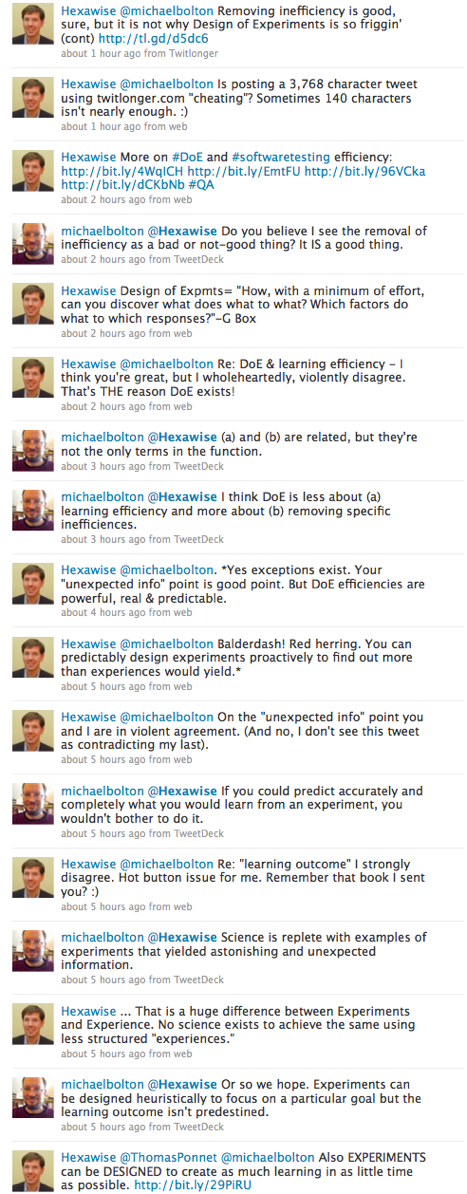Design of Experiments is about Learning ASAP and, in Software Testing, Finding Bugs ASAP

Design of Experiments is about Learning ASAP and, in Software Testing, Finding Bugs ASAP

Removing inefficiency is good, sure, but it is not why Design of Experiments is so friggin' powerful. Saying DoE is interesting to know about because it can help identify and remove specific inefficiencies is a bit like saying Canada is a good country to visit because you can sometimes find a good cup of coffee there. To my mind, saying DoE is primarily about removing inefficiency misses the main point.
Design of Experiments is so powerful because it allows practitioners to predictably, systematically, and consistently find out more useful, actionable information in much less time than they would otherwise take to obtain this information (if they could find it at all with their less-structured approaches).
In manufacturing circles (e.g., when engineers produce new prototypes), DoE's ability to do this is no longer questioned. This is because leaders like George Box taught people in industry how to apply DoE and they gathered conclusive evidence that DoE allowed manufacturers to learn much faster through techniques like applying factorial designs. Box and other DoE experts (Taguchi, Montgomery, my dad, etc.) dealt with skeptical manufacturing engineers for four decades by showing them the facts and using DoE on the skeptics' own projects right under their noses. The evidence that DoE allows manufacturers to learn much faster (about a wide variety of learning goals) than the other methods they used prior to 1960 is incontrovertible.
In 2010, in the gradually maturing field of software testing, Design of Experiments-based methods of test case design has not caught on much at all yet. As an industry, it's adoption of DoE-based approaches is roughly where manufacturing was in 1960. Most software testers, even very good ones, don't know anything at all about how DoE can help them. Many other software testers have heard a bit about pairwise but mistakenly think pairwise and related, structured, DoE-based, test case selection method can't help them.
Even some of the best testers in the world who have written some of the most clearly-written and well-reasoned articles about pairwise approaches do not (in my view) seem to fully-understand: (a) how powerful the benefits are, (b) how often the approach can be applied / in how many diverse kinds of testing situations they can be utilized, and/or (c) how consistently the efficiency and effectiveness benefits are be generated when they are used properly. DoE methods, including pairwise and n-wise and mixed strength automatic test condition generation (made possible by tools like our Hexawise tool and also, to a great extent by James Bach's free AllPairs tool) allow software testers to learn much faster about critically important questions like: (1) where are the bugs?, (2) what is causing the bugs to appear?, (3) am I confident I have efficiently tested for a huge range of combinations of values in the System Under Test that might trigger defects? (4) am I succeeding in avoiding redundant repetition of steps in many test cases?, (5) how many bugs would be likely to find if we were to continue to run the next 100 tests?, etc.
In summary, the reason for the existence of Design of Experiments methods (whether we're talking about their applicability to testing software as efficiently and effectively as possible, or DoE methods' applicability to a huge variety of other objectives) - and, for that matter, the reason that they have been continuously refined and improved for 40+ years - is that DoE methods consistently and predictably allow users to learn actionable results as quickly as possible.
Related: Maximize Test Coverage Efficiency And Minimize the Number of Tests Needed - Pairwise and Combinatorial Software Testing in Agile Projects - Video Highlight Reel of Hexawise


